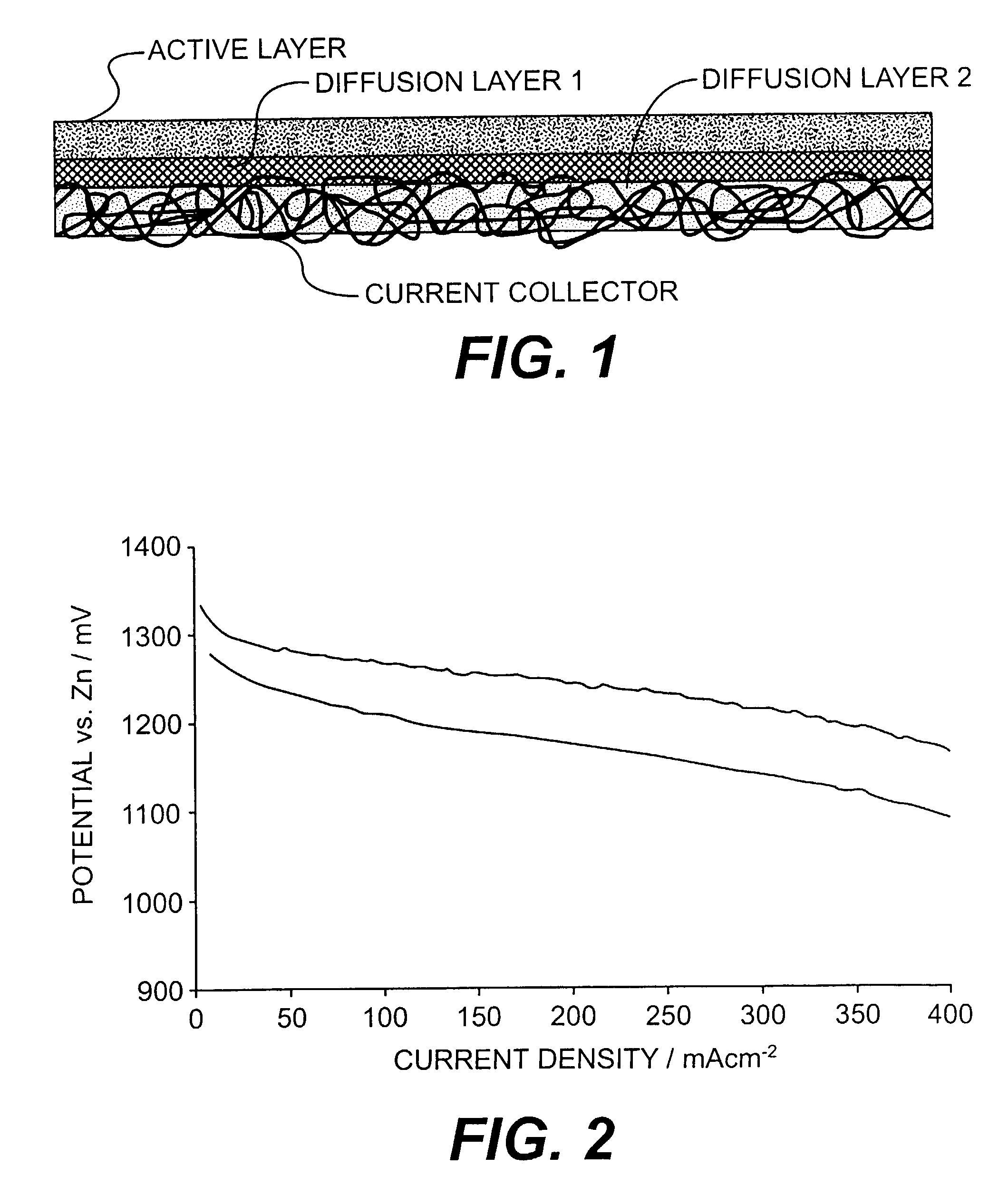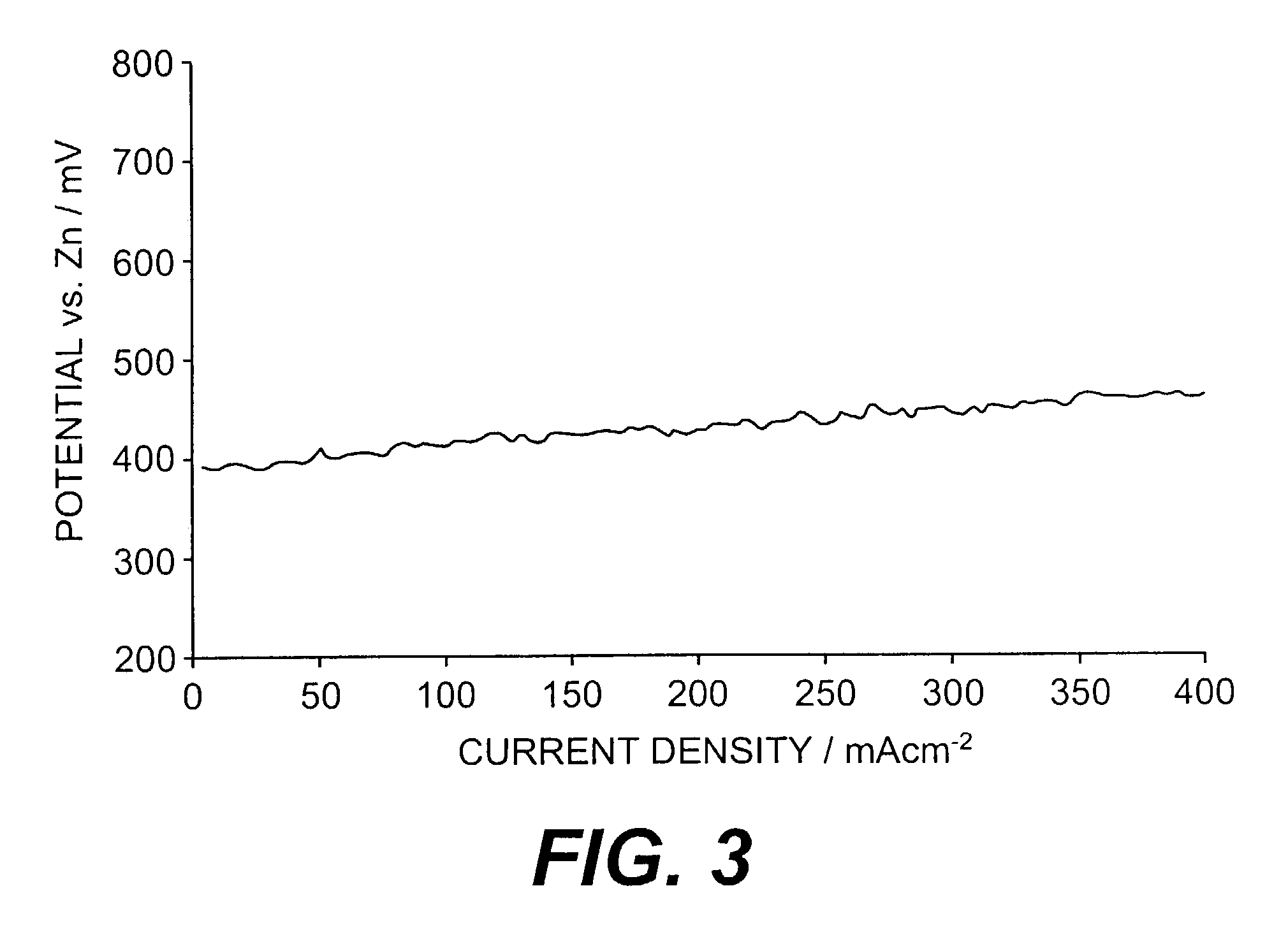Electrodes for alkaline fuel cells with circulating electrolyte
a fuel cell and electrolyte technology, applied in the direction of cell components, electrolyte stream management, electrochemical generators, etc., can solve the problems of high rejection rate, low flexibility, and high damage to electrodes, and achieve the effect of reducing the number of defective or rejected electrodes, dimensionally stable and highly flexible porous electrodes, and reducing the incidence of damage to electrodes during manufactur
- Summary
- Abstract
- Description
- Claims
- Application Information
AI Technical Summary
Benefits of technology
Problems solved by technology
Method used
Image
Examples
example 1
[0054]100 g of Cabot Vulcan XC-72 was suspended in 850 mL of 15% isopropanole (in demineralized water) using a vibration mixer. 55 mL of a solution containing 0.10 mol / L Al-nitrate and 0.05 mol / L Co-nitrate was added and mixed for three minutes. The suspension was dried over night at 150° C. Then, the carbon black was milled in a high speed mixer and activated at 950° C. in a small rotating tube furnace in 2Lmin−1 1 CO2-flow, medium residence time 45 min. This procedure was necessary to create a stable surface of the carbon.
[0055]1.00 g Dihydrogenhexachloroplatinate(II)-hexahydrate (H2 [PtCl6].6H2O) was dissolved in 100 mL demineralized water and heated to 60° C. in a water bath and stirred magnetically. 4 mL of 30% hydrogenperoxide (H2O2) was added. 20 mL of a fresh made 60 g / L solution of sodiumdithionite (Na2S2O4) was added over a period of 15 minutes. After another 10 minutes a suspension of 2.3 g activated Vulcan XC-72 in 250 mL demineralized water was added slowly, the water b...
example 2
[0065]100 g of Cabot Vulcan XC-72 was milled in a high speed mixer and activated at 950° C. in a small rotating tube furnace in 2 Lmin−1 CO2-flow, medium residence time 45 min. This procedure was necessary to create a stable surface of the carbon.
[0066]A 11 cm×11 cm piece of nickel foam (511 g / m2; 1.7 mm thick; from Retec, USA) was treated the same way as described in example 1.
[0067]12.0 g of Shawinigan Black (from Chevron Chemicals, USA), 5.6 g polyethylene (S-379N from Shamrock, USA) and 2.0 g polytetrafluoroethylene (TF 9207 Hostaflon from Dyneon GmbH, Germany) were milled five minutes in an high speed mixer. Then, the mixture was suspended in 600 mL of toluene containing 0.4 g of solved polyisobutene (Oppanol®, from BASF, Germany) at ambient temperature for 30 minutes stirring magnetically. The suspension was filtered and the “dough” was kneaded three times through a small pasta machine. The wet dough was filled into a bottle which could be closed tight (L1 and L2).
[0068]17.0 g...
example 3
[0073]100 g of Cabot Vulcan XC-72 was treated the same way as described in example 1.
[0074]A 11 cm×11 cm piece of nickel foam (511 g / m2; 1.7 mm thick; from Retec, USA) was treated the same way as described in example 1.
[0075]14.0 g of Shawinigan Black (from Chevron Chemicals, USA) and 5.6 g polyethylene (S-379N from Shamrock, USA) were milled five minutes in an high speed mixer. Then, the mixture was suspended in 600 mL of toluene containing 0.4 g of solved polyisobutene (Oppanol®, from BASF, Germany) at ambient temperature for 30 minutes stirring magnetically. The suspension was filtered and the “dough” was kneaded three times through a small pasta machine. The wet dough was filled into a bottle which could be closed tight (L1 and L2).
[0076]17.6 g of activated Vulcan XC-72 and 1.0 g polyethylene (S-379N) were treated the same way as described above to form a second dough (L3).
[0077]The layers L1, L2 and L3 were formed exactly the same way as described in example 2.
[0078]After press...
PUM
| Property | Measurement | Unit |
|---|---|---|
| density | aaaaa | aaaaa |
| density | aaaaa | aaaaa |
| temperature | aaaaa | aaaaa |
Abstract
Description
Claims
Application Information
 Login to View More
Login to View More - R&D
- Intellectual Property
- Life Sciences
- Materials
- Tech Scout
- Unparalleled Data Quality
- Higher Quality Content
- 60% Fewer Hallucinations
Browse by: Latest US Patents, China's latest patents, Technical Efficacy Thesaurus, Application Domain, Technology Topic, Popular Technical Reports.
© 2025 PatSnap. All rights reserved.Legal|Privacy policy|Modern Slavery Act Transparency Statement|Sitemap|About US| Contact US: help@patsnap.com



